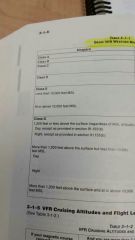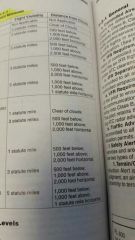![]()
![]()
![]()
Use LEFT and RIGHT arrow keys to navigate between flashcards;
Use UP and DOWN arrow keys to flip the card;
H to show hint;
A reads text to speech;
32 Cards in this Set
- Front
- Back
|
POH limitations and capacities |
Weight-2558, Takeoff-2550, Landing-2550. Capacities-56 Gallons of fuel, 53 Gallons usable, 3 Gallons unusable. 8 quarts of oil. Fuel Grade-100LL (Blue) 100 (Green) DON'T NOT USE IN AIRCRAFT- 80 (Red) Jet A (Clear/Straw) |
|
|
Vso |
40, minimum speed at which the airplane is controllable in the landing configuration at the most forward COG |
|
|
Vs1 |
48, Minimum steady flight speed at which the airplane is controllable. |
|
|
Vx |
62, Best angle of climb in a given distance. |
|
|
Vy |
74, Best rate of climb in a given time. |
|
|
Va |
2550-105 2200-98 1900-90 Maneuvering speed. |
|
|
Vno |
129, Maximum structural cruising speed |
|
|
Vne |
163, Never exceed speed |
|
|
ATOMATOFFLAMES |
A-Airspeed indicator T-Tachometer for each engine O-oil pressure gauge for each engine using pressure system M-Magnetic direction indicator A-Altimeter T-Temperature gauge for each liquid cooled engine O-oil temperature gauge for each air-cooled engine F-Fuel gauge F-Flotation gear L-landing gear A-anticollision light system M-Manifold pressure gauge for each altitude engine E-Emergency locator transmitter S-Seat belts |
|
|
Pilot limitations |
A student pilot may not act as pilot in command of an aircraft that is 1.carrying a passenger. 2.is carrying property for compensation or hire. 3.for compensation or hire 4.in furtherance of a business. 5.may not operate an aircraft on a solo flight in class B airspace. |
|
|
Right of way rules |
Give right of way to aircraft In distress Converging (right) Approaching head-on Overtaking Landing |
|
|
Steady green light |
Cleared to takeoff/land |
|
|
Flashing green |
Cleared to taxi/return for landing |
|
|
Flashing green |
Cleared to taxi/return for landing |
|
|
Steady red |
Stop/give way to other aircraft and continue circling |
|
|
Flashing red |
Taxi clear of runway in use/airport unsafe, do not land. |
|
|
Flashing white |
Return to starting point on airport/ does not mean anything for landing |
|
|
Alternating red and green |
Exercise extreme caution on takeoff and landing |
|
|
What are the personal documents required for flight |
Pilot certificate Medical certificate Authorized photo ID Restricted radiotelephone operator license |
|
|
ARrOW |
Airworthiness certificate Registration certificate Radio station license Operating limitations Weight and Balance data |
|
|
AVIATE |
Annual inspection (every 12 cal. Months) VOR (every 30 days) 100 hour inspection Altimeter, altitude reporting and static system (every 24 cal. Months) Transponder (24 months) ELT (12 months) |
|
|
WKRAFT |
Weather reports and forecasts Known traffic delays as advised by ATC Runway length of intended use Alternatives available if flight cannot be completed as planned Fuel requirements Takeoff and landing performance data |
|
|
Types of altitude |
Indicated altitude Pressure altitude Density altitude True altitude Absolute altitude |
|
|
Types of speeds |
Indicated airspeed Calibrated airspeed Equivalent airspeed True airspeed Mach number Ground speed |
|
|
DVMONA |
Deviation Variation Magnetic dip Oscillation North/south turn errors Acceleration errors |
|
|
Conditions necessary for the formation of thunderstorms |
Sufficient water vapor (humidity) An unstable temperature lapse rate An initial uplifting force |
|
|
Life cycles of thunderstorms |
Cumulus stage Mature stage Dissipating stage |
|
|
Vr |
Rotate speed 55 |
|
|
Vfe 1rst |
1st notch of flaps under 110 |
|
|
Vfe >1rst |
Second and third notch of flaps 85 (in the white arc) |
|
|
Vg |
Best glide speed 68 |
|

|

|

